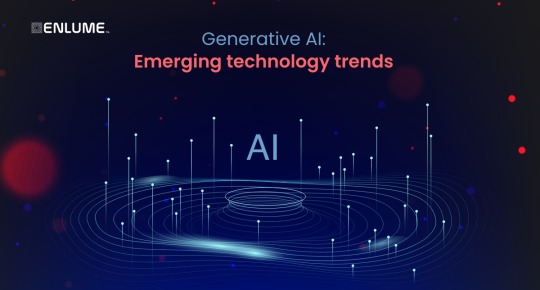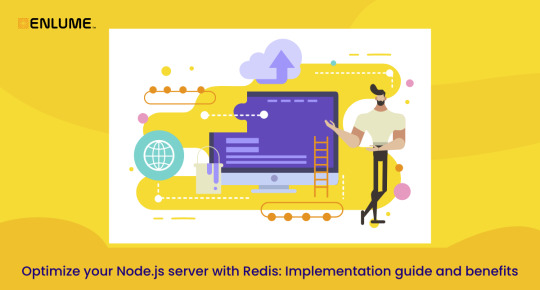#Enlume
Explore tagged Tumblr posts
Text
Responsible AI development: Ensuring ethical and beneficial AI
Artificial intelligence (AI) is revolutionizing industries, driving innovation, and redefining how businesses operate. From automating repetitive tasks to uncovering actionable insights through big data, AI offers unparalleled opportunities. However, as AI technologies proliferate, they also bring ethical dilemmas and risks. Responsible AI development is no longer optional—it's a business imperative for decision-makers aiming to build trust, safeguard societal interests, and future-proof their innovations.
In this article, we’ll explore why ethical considerations in AI development are essential, the key principles of responsible AI, and practical steps to integrate these principles into your organization’s AI strategies.
The importance of responsible AI
AI systems are only as good as the data and algorithms that power them. When poorly designed or improperly deployed, AI can perpetuate biases, invade privacy, and lead to unintended harm. Several high-profile incidents, such as biased hiring algorithms or discriminatory facial recognition systems, have underscored the consequences of unethical AI practices.
For decision-makers, these lapses can result in reputational damage, legal ramifications, and loss of trust among customers and stakeholders. Responsible AI development mitigates these risks while fostering innovation that aligns with organizational values and societal expectations.
Key principles of responsible AI
Fairness and inclusivity: AI systems must be designed to treat all individuals and groups fairly. This involves actively identifying and addressing biases in datasets and algorithms. Inclusivity also means considering diverse perspectives during development to ensure the technology benefits everyone.
Transparency and explainability: Decision-makers must prioritize AI models that are transparent and explainable. Stakeholders, including end users, should understand how decisions are made, especially in high-stakes scenarios like healthcare, finance, and law enforcement.
Privacy and data protection: Responsible AI requires robust measures to safeguard user data. This includes adhering to global privacy regulations like GDPR and implementing data minimization practices to reduce exposure.
Accountability and governance: Clear accountability frameworks are vital. Organizations must establish governance structures to oversee AI initiatives, ensuring they adhere to ethical guidelines and are regularly audited for compliance.
Social and environmental impact: AI solutions should contribute positively to society and minimize their environmental footprint. This involves designing applications that address global challenges, from climate change to healthcare access.
Practical steps for decision-makers
1. Establish ethical AI guidelines
Start by defining your organization’s core ethical principles for AI development. Align these principles with industry standards and global frameworks, such as the OECD AI Principles or UNESCO’s Recommendation on the Ethics of AI.
2. Conduct bias audits
Regularly assess datasets and algorithms for biases. Leverage tools like IBM AI Fairness 360 or Microsoft Fairlearn to identify and mitigate potential disparities in AI outputs.
3. Foster cross-functional collaboration
AI ethics should not be confined to the tech team. Engage diverse stakeholders, including legal, compliance, and HR teams, to build holistic AI systems that consider broader societal impacts.
4. Invest in explainability tools
Use AI explainability frameworks, such as SHAP (SHapley Additive exPlanations) or LIME (Local Interpretable Model-Agnostic Explanations), to make complex AI decisions understandable to non-technical users.
5. Monitor and govern AI systems continuously
Ethical AI development is not a one-time effort. Implement monitoring systems to track AI performance over time and establish a governance board to oversee compliance and address ethical concerns.
Benefits of responsible AI development
1. Trust and reputation
Organizations that prioritize ethical AI earn trust from customers, investors, and regulators. This trust translates into stronger brand loyalty and a competitive edge in the market.
2. Risk mitigation
By addressing ethical concerns early, businesses can avoid costly legal disputes and regulatory penalties.
3. Innovation and longevity
Ethical AI fosters sustainable innovation. By focusing on long-term benefits over short-term gains, companies ensure their technologies remain relevant and impactful.
Case studies
Example 1: Google’s AI principles
Google developed a set of AI principles to guide its projects, focusing on safety, fairness, and accountability. This approach has influenced how the company assesses and deploys AI technologies across sectors.
Example 2: Microsoft’s AI for good initiative
Microsoft's "AI for Good" program uses AI to address global challenges, such as accessibility for individuals with disabilities and environmental conservation. This initiative demonstrates the power of aligning AI innovation with societal benefits.
Conclusion
The rise of AI presents both tremendous opportunities and significant responsibilities. Decision-makers have a unique role in shaping the future of AI by fostering ethical development practices.
By embracing responsible AI, your organization can lead with purpose, build trust with stakeholders, and drive sustainable growth. It’s not just about developing smarter systems—it’s about creating systems that are fair, transparent, and beneficial to all.
Are you ready to lead the charge in ethical AI development? Let’s build a smarter, fairer future together. Subscribe to EnLume Insights and follow EnLume Inc. for the latest trends, innovations, and actionable strategies.
#ai ml solutions#ai ml development services#ai development#enlume#enlume inc#Ai Develop#ai development company
0 notes
Text

Crow. detail. French 1447 Enlum. by tony harrison
18 notes
·
View notes
Photo

Leverage EnLume’s Product engineering services such as cloud native, enterprise, web application development, and QA services across the entire Product Development Lifecycle to achieve Scalability, Faster time-to-market, Cost optimization and Accelerated innovation.
0 notes
Text
Survey Stories #2 - How successful teams reduce emails with Flock
Last week, we showed you how successful teams have used Flock to significantly increase their productivity by 60 percent.
In this blog post, we’re sharing how teams use their favorite team communication app, Flock, to save considerable time and effort spent in communicating via email.
65% of our users claim to have reduced their dependency on email — they now use Flock to share important updates, send messages, and share files.
How have our users been able to reduce their dependence on a tool that has been around for so long? Here’s the secret sauce:
They manage time-sensitive issues by sending direct messages on Flock
Users no longer have to draft an email, proofread it, attach files, and then send it. They can simply message someone on Flock and get an instant response.
It’s just that easy to bring an issue to someone’s notice, in no time at all. No longer do important, urgent tasks become a headache.
Flock is super easy to use and great for communication, fusing the benefits of email and texting into one app!
K Ruddiman, Suretec
Users can share all types of files, and never worry about attachments ever again
Sending attachments can be a pain; you either forget to attach a file or attach the wrong file. And going back and searching for a file that someone emailed you can be like looking for a needle in a haystack.
With Flock, sharing and finding valuable files is no longer a problem. Our users share all kinds of documents, files, and folders with a simple ‘drag and drop’.
What’s more, they use the My Favorites app to ‘star’ anything important and get back to it any time later.
Less emails, faster communication, easier project coordination — Anna Mikulska, MJCC
They use business apps to track and share progress on projects and documents
Our users say that Flock is a great tool to do so much more than just messaging and communication. With Flock’s business apps such as Shared To-Dos and Reminders, they can track project updates and never miss a thing. Users can significantly reduce back and forth on emails for tiny, but vital updates.
Shared To-Dos
Reminders
It is truly a handy solution for managers. It helps stay on top of things. I love the Shared To-dos and the apps integration. Getting Google Analytics reports and notification from Twitter whenever my social media team posts something is really handy.
Dhiraj Gautam, Enlume
They use the Mailcast app to send group emails
Does sending an email to the entire team seem like a herculean task? Well, not for Flock users. They absolutely love the Mailcast app that allows them to send emails to teams and channels. Flock creates unique URLs for all teams and channels so that our users can send an email to the entire channel or team at one go, from within Flock.
I can confidently say that Flock has made our work life happier — It’s seamlessly fast, making it easy to communicate with colleagues. I love that we don’t need to write emails for mundane things anymore
Yogesh, The Neon Tree
Time to say goodbye to long mail trails. With Flock, simply send a message and you’re good to go!
Next in the series: How do teams increase transparency at their workplace?
Got a minute? Check out these stories
Survey Stories #1 - How successful teams increase productivity with Flock
The myth of the cool job
Survey Stories #2 - How successful teams reduce emails with Flock was originally published in Flock Blog on Medium, where people are continuing the conversation by highlighting and responding to this story.
0 notes
Text
0 notes
Text
0 notes
Text
Generative AI: Emerging technology trends

Generative AI is no longer a futuristic concept—it's rapidly becoming an integral part of how industries innovate, create, and operate. By harnessing the power of deep learning models, generative AI is reshaping everything from content creation to product design, offering unprecedented capabilities in generating text, images, music, and even complex software code. Unlike traditional AI that focuses on classification or prediction, generative AI is all about creativity and originality, producing new, never-before-seen outputs based on patterns it has learned from vast amounts of data. This leap in technology has sparked a revolution across sectors like entertainment, healthcare, finance, and software development, driving both efficiency and creativity at scale. As generative AI tools become more sophisticated, they offer the promise of not only enhancing productivity but also fostering innovation in ways previously thought impossible. In this article, we'll explore the cutting-edge trends that are shaping the future of generative AI, offering insights into how this transformative technology is influencing industries and paving the way for new advancements.
The rise of multi-modal AI
Traditional AI models often operated within specific domains, excelling at either text generation, image creation, or audio synthesis. However, the emergence of multi-modal generative AI has been a game-changer. Models like OpenAI’s GPT-4 Vision and Google’s Gemini integrate text, visual, and auditory capabilities seamlessly. These systems can analyze diverse inputs, such as interpreting a complex chart while generating an explanatory narrative or suggesting improvements based on the context.
The ability to understand and generate across modalities has profound implications. For example, in healthcare, a multi-modal AI can process medical images and patient histories simultaneously, offering diagnostic insights with greater accuracy. Similarly, e-commerce platforms are leveraging these models to create personalized shopping experiences by combining user preferences with dynamic visual recommendations.
Diffusion models: The new backbone of content creation
Diffusion models are revolutionizing generative AI by enabling the creation of high-quality, hyper-realistic content. Unlike traditional methods that start from structured data, these models begin with noise and iteratively refine it into coherent outputs, be it a stunning piece of digital art or a lifelike audio sample. Open-source tools like Stable Diffusion have democratized access, allowing developers and creators to experiment with this powerful technology.
The implications of diffusion extend beyond static visuals. The latest advancements support video generation and interactive 3D content, which is reshaping industries such as entertainment and virtual reality. Moreover, diffusion’s ability to synthesize diverse elements is creating opportunities for dynamic user-generated content in gaming and immersive marketing campaigns.
AI-Powered software development
Generative AI is becoming an integral part of the software development lifecycle, enabling unprecedented levels of automation. Advanced tools like GitHub Copilot and Tabnine assist developers by generating code snippets, debugging, and even optimizing entire algorithms. The technology has evolved from providing suggestions to actively participating in the creative and technical aspects of software engineering.
One of the most exciting developments is the training of domain-specific AI models tailored to industries such as finance, healthcare, and logistics. These models are capable of generating architectures, writing secure APIs, and automating repetitive coding tasks. This shift is not only accelerating development timelines but also empowering non-technical stakeholders to participate in creating functional prototypes.
Ethics and transparency in Generative AI
As generative AI grows more sophisticated, ethical considerations have come to the forefront. The risks of bias, misinformation, and intellectual property theft demand robust solutions. Recent innovations include embedding watermarks to identify AI-generated content, implementing strict content moderation protocols, and conducting regular audits of AI systems.
Transparency is becoming a key component of generative AI development. Developers are introducing explainability frameworks that allow users to understand how models make decisions. Such measures are crucial for ensuring trust, particularly in high-stakes domains like healthcare, finance, and public policy.
The intersection of AI and edge computing
Generative AI is no longer confined to the cloud. The integration of AI with edge computing is enabling real-time processing on devices like smartphones, drones, and IoT sensors. This shift is driven by advances in model compression techniques, which make it feasible to run complex algorithms on hardware with limited computational power.
Applications of edge AI include smart cameras capable of identifying threats in real-time, portable diagnostic tools for remote healthcare, and AR-enabled devices that generate context-aware virtual overlays. This decentralized approach not only reduces latency but also enhances privacy by keeping sensitive data local.
Generative AI meets quantum computing
The convergence of generative AI and quantum computing is poised to unlock unprecedented possibilities. Quantum computers excel at solving optimization problems, making them ideal for training and running large-scale generative models. While still in its infancy, this intersection promises breakthroughs in areas like drug discovery, climate modeling, and complex simulations.
For instance, pharmaceutical companies are exploring quantum-enhanced generative AI to simulate molecular structures, accelerating the development of new drugs. Similarly, industries reliant on predictive analytics, such as finance and logistics, are investing in quantum-powered systems to optimize decision-making at scale.
Hyper-personalization and beyond
Generative AI is redefining personalization by tailoring content and experiences for individuals at an unprecedented scale. From custom workout plans generated by fitness apps to bespoke fashion recommendations in retail, AI-driven systems are creating unique value for users. Emerging trends include synthetic influencers—AI-generated personas capable of interacting with audiences in highly personalized ways.
Hyper-personalization extends into education and training, where generative AI creates adaptive learning modules tailored to individual progress. This level of customization is not only enhancing engagement but also driving better outcomes across sectors.
The road ahead
Generative AI is not just reshaping the current technological landscape—it’s charting an entirely new course. As it continues to evolve, it will not only enhance the capabilities of existing applications but also unlock completely new possibilities in industries ranging from entertainment and healthcare to education and software development. At the heart of this transformation is its ability to generate highly realistic text, images, audio, and even code, enabling more efficient workflows, reducing human error, and fostering creativity. But this is just the tip of the iceberg.
The integration of generative AI with emerging technologies like quantum computing promises to elevate its power to new heights. Quantum computing's ability to process vast amounts of data at unprecedented speeds could vastly improve the way generative AI models are trained and deployed, potentially enabling real-time content creation and more accurate simulations. Additionally, as AI moves to the edge—on devices like smartphones, smart speakers, and even wearables—its potential to deliver seamless, personalized user experiences is becoming a reality. With AI running locally on edge devices, we could see quicker, more responsive interactions without the need for constant cloud communication.
Yet, with this potential comes a pressing question: how can businesses effectively balance innovation with ethical considerations? As generative AI becomes increasingly powerful, ensuring that it is used responsibly and inclusively will be critical. We’re already seeing concerns around issues like bias in AI models, the ethical use of generated content, and data privacy. So, how do we build AI systems that are both groundbreaking and accountable?
The journey of generative AI has only just begun, and its implications are far-reaching. As we move forward, it’s essential to not only push the boundaries of what’s possible but also to focus on the broader societal impacts. It’s about creating a future where the benefits of AI—whether they be in automating mundane tasks or empowering new forms of human creativity—are accessible to all, regardless of geography, background, or resources. Businesses that embrace these trends early will have a significant competitive advantage, not just by fostering innovation but also by demonstrating leadership in ethical AI implementation.
As we look to the future, one thing is clear: the road ahead is filled with immense promise. The next few years will be pivotal in shaping how generative AI is integrated into our daily lives and the technological infrastructure of the world. What role will your organization play in this transformative journey? EnLume
0 notes
Text
0 notes

